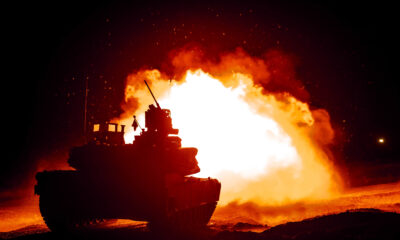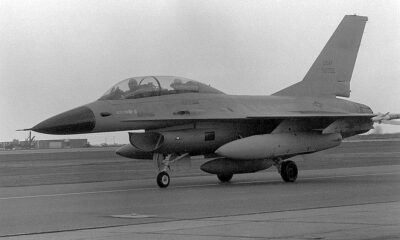Civilization
A Shrunken Arsenal: The Alarming Decline of U.S. Munitions
America’s armed services are critically short of munitions, the price of supporting two allies at once with munitions.

As fighting rages in the Middle East and Europe and China looms as a threat, America’s dwindling arsenal of high-end munitions emerges as an alarming crisis. The United States, once a fortress of military might, now faces the prospect of a munitions deficit in an era brimming with uncertainties. This desperate situation demands the development of a national critical munitions stockpile.
European weapons makers are overwhelmed and struggling to meet Ukraine’s consumption of more than 6,000 artillery rounds each day during peak counteroffensive fighting. Ukraine’s ability to stave off defeat and defend itself against the Russian invasion largely depends on an uninterrupted supply of these rounds. Ukrainian forces are conserving their ammunition supply, which might lead to postponements in upcoming counterattacks. Over the coming months, this shortage of ammunition could compel Ukrainian military units to make difficult choices regarding the allocation of resources across various frontlines, focusing on areas where maintaining control is most crucial and potentially allowing minor territorial losses in less critical sectors.
To supplement Ukraine’s massive ammunition requirements, DoD pulls munitions from its own war reserve stocks. Further compounding the matter: In an attempt to extract stricter immigration policies, House Republicans are blocking a congressional aid package for Ukraine.
Last year, to help meet the demand for Ukrainian munitions, the Pentagon tapped into a stockpile of American 155mm rounds in Israel, sending hundreds of thousands to Ukraine. These rounds, stored for decades in Israeli bunkers, are to provide an Israeli qualitative military edge, a pillar of American policy in the Middle East. Now Israel needs them back to target Hamas’s command cells in its war in Gaza. The U.S. is supporting two countries, both of which use enormous amounts of 155-millimeter artillery and other ammunition in wars that may stretch on for many months. Running out of ideas, last month the Pentagon established a team to examine American inventories to identify ammunition for Israel. Earlier this month, Senator Deb Fischer, a senior Senate Armed Services Committee member, remarked that the U.S. must expand its munitions production capability.
Once a conflict begins it can lead to extraordinarily high munitions consumption. The fighting in Ukraine should serve as a warning regarding production of munitions the U.S. would need in a conflict with China over Taiwan. The U.S. must resolve the extensive issues within its munitions manufacturing processes ahead of a conflict with China.
American forces require an enormous volume of critical munitions to fight against a technologically advanced military force. This ammo is also necessary to equip partner forces in Asia, such as Australia, with the long-range anti-ship munitions needed to defeat the Chinese flotilla or prevent it from ever embarking. The stockpile also ensures that American industrial output is sustained in times of crisis and preserves the United States’ global military edge.
The U.S. also provides Taiwan with munitions sufficient to blunt an initial Chinese blow. This strategy – codified by the 1979 Taiwan Relations Act – involves ensuring Taiwan has sufficient defense capabilities against a Chinese attack. The U.S. arms Taiwan only to a level that does not disrupt the diplomatic equilibrium between Washington and Beijing. But, there is growing concern in the Pentagon and the Indo-Pacific that Taiwan does not have enough of the high-tech munitions to hold off a PRC attack. Here again, the shrinking U.S. munitions reserve represents a risk.
In a U.S. fight with China, American forces will likely burn through munitions stocks within three weeks. Even with a surge of the U.S. industrial base, replenishing stocks will take more than six months. In the interim, the U.S. will be without sufficient bombs and bullets for its cutting-edge systems, such as fifth-generation fighter jets and High Mobility Rocket Launcher Systems, and anti-air missiles needed to protect our nuclear aircraft carriers and bases in the Pacific.
Right now, the warning indicators are blinking red. The massive need for ammunition in such conflicts highlights weaknesses in the American defense industry, which no longer produces munitions at the rate it did decades ago. The post-Cold War defense budget reductions led to a swift merger of the defense sector, which saw a drop from fifty-one major defense providers in the early 1990s to five by the end of that decade. This consolidation led to a tightened capacity.
To arm our allies and partners and our own forces to deter and, if necessary, fight a major theater war, the United States requires a critical munitions stockpile. This reserve will enable the Department of Defense to restore essential munitions stocks vital for maintaining air dominance, defending against air and missile threats, and targeting hard and deeply buried objectives.
The PROCURE Act, introduced by a bipartisan group of senators in the previous Congress, would go a long way toward building this stockpile. The legislation aims to establish a $500 million per year revolving fund in the Treasury Department for the Pentagon to procure critical munitions. This fund would allow the Defense Department to swiftly replenish high-demand munitions supplied to partner countries in future conflicts, using profits from the U.S. Foreign Military Sales program. The act is designed to support democratic nations and protect American interests overseas, allowing the Pentagon to continuously order critical munitions. The Senate Armed Services Committee should push to get the PROCURE act passed into law.
In addition, we must expand the National Defense Stockpile, a largely obscure reserve of raw material based in Fort Belvoir, Virginia, with operations throughout the United States. The National Defense Stockpile holds an emergency supply of 50 critical minerals. Many of these minerals, such as aluminum, titanium, and magnesium, are used in the production of munitions. The value of materials in the U.S. National Defense Stockpile has drastically decreased from $42 billion in 1952 to less than $1 billion today. America’s mineral reserves are significantly lower than China’s, with the National Defense Stockpile maintaining only 300 metric tons of cobalt compared to China’s 7,000 metric tons. Congress must expand the National Defense Stockpile to support a potential major theater war.
Our munitions stockpiles and production capacity are not just inadequate; they are a glaring vulnerability in our national defense strategy. We must act with resolve and urgency to revitalize our defense industrial base and expand our reservoir of munition-production minerals. Nothing less than our national interests and global stability is at stake.
This article was originally published by RealClearDefense and made available via RealClearWire.
Joe Buccino is a research analyst at the Defense Innovation Board, a former communications director at U.S. Central Command, and a retired U.S. Army colonel with five deployments to the Middle East during his military career. He served as the communications director for the NATO support mission in Europe from February to November 2022.
-

 Education3 days ago
Education3 days ago‘Grading for Equity’: Promoting Students by Banning Grades of Zero and Leaving No Class Cut-Ups Behind
-

 Family3 days ago
Family3 days agoIdaho defends against abortion mandate
-

 Civilization4 days ago
Civilization4 days agoNewsom plays silly abortion politics
-

 Constitution2 days ago
Constitution2 days agoPresidential immunity question goes to SCOTUS
-

 Civilization4 days ago
Civilization4 days agoWaste of the Day: China Still Owes Over $1 Trillion to American Bondholders
-

 Civilization4 days ago
Civilization4 days agoCurrent Conflicts Demonstrate Need for More and Better Tanks In Eastern Europe
-

 Civilization2 days ago
Civilization2 days agoMarine Corps Force Design: In Defense of Chowder II
-

 Education3 days ago
Education3 days ago‘Grow PA’ Plan Helps Solve Economic, Higher Education Challenges










